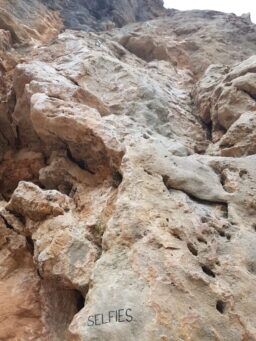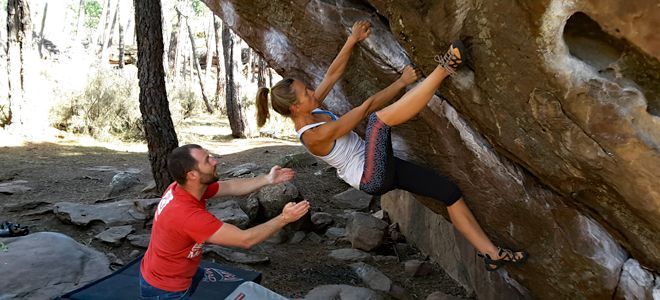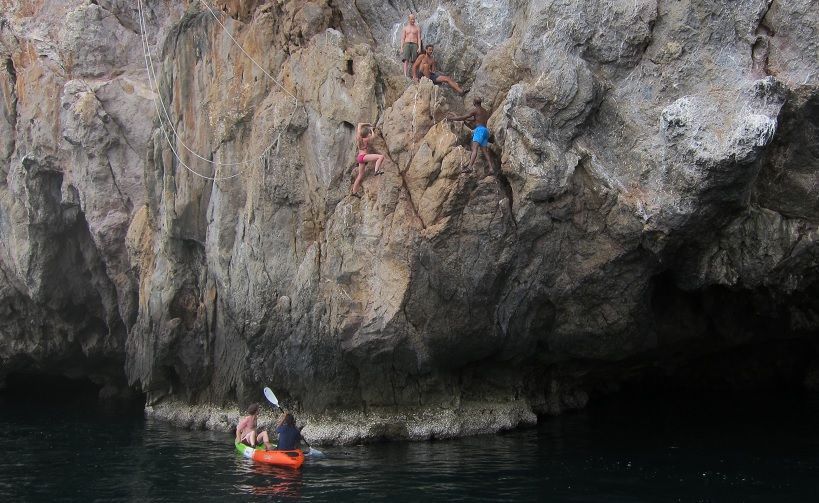New Routing
If you follow Rock & Sun on Facebook, Instagram or via our Newsletter, you would have seen a few posts this year about the new routes we developed in the Costa Blanca during the Corona pandemic. Here we will describe what it entails to make them, what we love about new-routing, plus we’ll give the overview of all the new routes as most of them were developed just after the new Costa Blanca guidebook by Roberto Lopez was published. We also aim to answer the questions you’ve been asking us about developing new routes. If you have more questions after reading this blog, please send us a message and we will add it to this blog.
New-routing during Covid-19
International borders being closed for tourists for most of the time between March 2020 and May 2021 meant that we had a lot of time on our hands in the last year or so. Once the initial and very strict lockdown in Spain ended and we were slowly gaining more freedom again, we at first felt it could be considered too ‘frivolent’ to start climbing for fun again. But we considered going to the crag to create new climbs a justified reason to go to the crag. The first routes we started to work on were the 4 routes ‘in the trees’ in sector Alejandria of Pena Roja (see the full overview of new routes at the bottom of this blog). Trev had his eye on this sector mainly because of the easy angled rock and the fact that it is protected from the sun by the trees. If we could create some routes here, that would allow us to climb at Pena Roja all day; starting in Alejandria-riverbed in the morning, then move into the trees, and finish the day at the original wall of Pena Roja.
What is your motivation for developing routes?
A question we get asked quite regularly, as most climbers ‘just’ climb and never put up a route in their whole life. Routesetters can be quite invisible, and unless you get to see someone developing a route, you may never really think about how and why those bolts got there.
There are several reasons why we like to get involved in bolting routes. One is because we are well aware of the fact that as Rock & Sun we use the Costa Blanca for our Sport Climbing Holidays and Performance Coaching Courses. We climb routes that have been equipped by others, we bring more climbers to this area. We therefore find it important to do something back. Not only by maintaining existing routes or sectors (we for instance replaced 10 anchors at Sierra de Toix Oeste with titanium glue in anchors), but also by creating more routes. This will give the locals something new to climb, and it will give climbers from other areas something to come back to the Costa Blanca for, and it means that on busy days at popular crags, people can spread over a greater number of routes without having to wait for one another.
Another important reason to develop new routes is so that when we are working with our groups, we can organise our climbing days in a different way and thereby offer our clients better climbing experiences. By for instance creating routes that are in the shade around midday, it means that when it’s hot we can climb in the shade all day, moving from one sector to the next, instead of having to go back to the villa for a two or three hour break before heading out to the crag again. And it also means our regular clients will have something new to try on their next trip. Finally, the routes we set tend to lend themselves really well for climbing coaching; they are good routes to practice route-finding and/or work on technical movement patterns.
The whole creative process from spotting to bolting new lines is our third motivation. We all have a different creative outlet; some of us sing, make music, love cooking, painting or making furniture. For us, it is new routing that ‘ticks us’. Trevor is naturally looking for new route potential at any crag we go to, even at any crag or piece of rock we drive past. He is always spotting natural lines or striking features that would be amazing to climb. Those of which that are on shady crags, with a potential grade range from 4s to 6s are the top of our list to have a closer look at and decide to start working on. What Desiree loves most about this creative process, are first, the uniqueness of climbing an unclimbed piece of rock and the freedom to decide where it climbs best, and second, the removing of loose rock, vegetation and mud, behind which you often find beautiful handholds.
These cleaning activities naturally lead us to our final motivation of new-routing: it is a great way to get fit. After 2,5 months in total lockdown, having drunk and eaten more than we could burn off, we had some kilos to lose and muscles to regain. Hanging in the harness all day, jumarring up the fixed line, using a crow-bar to get body-size blocks of rock off, hammering other loose rock off, drilling and brushing provides a quite intense full-body workout.

Do you need permission or a qualification to make new routes?
There is no qualification for route-setting. It is a skill that is often passed on from an experienced route-setter to an ‘assistant’ to learn all the ins and outs involved with doing a good job at it.
Whether permission is needed completely depends on where we want to develop new routes. If the land is privately owned then of course we’d need permission from the land owner. As it happens though, on more than once occasion it has been the other way around, and Trevor has been asked if he would please come to have a look at a limestone wall and develop routes there. These instances were in Thailand, where the owners see the potential of building bungalows and a restaurant to accommodate the climbers, once the routes have been developed. A win-win situation.
If the crag is on public land, we ask around among local climbers to see if permission would be needed from the forestry commission and/or from the municipality. For the past year we have wanted to start developing this untouched, north-facing crag, not far from where we live. We explored it on a few occasions and see great potential, but after talking to some local climbers we decided that now is not the right time to ask permission from the local government. So we will save that crag for another time in the future.
On existing crags, we use the following logic. If it is an established crag where there haven’t been new additions for a while, then we assume that the original route developers have finished the lines that they want to put up. And that they would not be against us developing more routes. Most local developers are, A: not interested in removing tons of loose rock or vegetation, and are B: not interested in bolting low 6s, 5s or 4s. Whereas those grades are of great interest to us. The routes at the Alejandria sector in the trees for example, from Estado de Alarma till Distanciamiento Social, took a lot of effort to get cleaned. We spent multiple days up there with a crowbar and lump hammer to make this area safe for climbing. And possibly more surprisingly, the sector at Alcalali from Artmosphere till The Baker was never developed before because the rock was invisible behind the trees and bushes that were growing on its ledges. Once we cut those down, a beautiful compact slab appeared with four striking lines. We opened this sector in November 2020, and with Alcalali being the perfect winter crag in the Costa Blanca, these routes were popular right from the start.
Finally, if the crag we have spotted a line on is still in development, which was the case for Murlali, we ask the people who are bolting there whether they are planning to bolt the line that we have seen. For “Cuando termine el cierre” we were given permission to go ahead and develop that route. The last thing you want of course when you are aiming to contribute to a climbing area is to upset the other developers and climbers in that area.

How much does a route cost?
This depends on the materials used. Titanium bolts that need to be glued in with a special waterproof glue (Hilti RE500, see our blog on placing titanium bolts) are more expensive than 12mm expansion bolts, which are more expensive than 10mm expansion bolts. And expansion bolts come in different alloys that vary in cost and durability. It also depends on the length of the route, or more precisely, how many bolts are needed to protect the route. Besides the material going into the route itself, there are the associated costs of the tools and protective equipment: a cordless battery-powered hammer drill (we use the Hilti Te4-A22), drill bits, ropes, saws, brushes, etc.
We estimate that on average a route costs £75.
Is there a bolt fund? How can I contribute?
In the Costa Blanca there is no bolt fund. We feel it is our obligation to contribute to the maintenance and development of this area and have been investing in it using our own funds. We do of course welcome contributions and have set up a donation page in the Rock & Sun Shop. For a £75 donation you get to name the route. Climbers visiting us in the Costa Blanca can contribute by buying a Rock & Sun t-shirt or renting our climbing shoes, harnesses, or helmets; all this income goes towards route development and route maintenance in the Costa Blanca.
How many days does it take to make a route?
On average it takes 2 days to develop a route. This however completely depends on whether it is the first route on a sector and we need to get access to the top of the crag, or whether we are creating a new route next to an existing one, in which case we can simply traverse across from the existing anchor. Besides the ease or difficulty of getting access to the top, the time it takes to make a new line also depends on the amount of vegetation and loose rock that needs to be removed.

What is the process of making a new route?
First we need access to the top of the crag. Sometimes it is possible to walk to the top of crag and set up a temporary anchor there, using trees and or trad gear. When that is not possible and it is also not possible to traverse across from an existing anchor, then Trevor will trad climb up a route from the ground and make a trad anchor at the top. This anchor is not necessarily in the spot where the final anchor will be but can be used during the routesetting process. Once a line is fixed, we can haul the drill up and drill 12mm holes to place Petzl removable bolts and take out the trad gear.
Using the temporary anchor, we set up a toprope. Both of us climb the ‘line’ at least twice. Do we choose similar ways to climb this unclimbed piece of rock? Does it go where we thought it would when we were looking at it from the ground? Is it a worthwhile route that we can make safe and fun to climb?
Once agreed on where the route goes (more or less) we climb it again to mark where the bolts go. This is a very interactive process between climber and belayer, and a lot of thought goes into it. Ultimately we want the bolts to 1) be in solid rock, 2) protect the climbing, 3) be in comfortable clipping positions for short and tall people, 4) allow the rope to run more or less in a straight line. Other considerations are that the bolt should not interfere with hand-or footholds, that the quickdraw should be hanging ‘free’ in the bolt (not pressed against or over the rock below the bolt). We both climb it several times, marking, erasing and re-marking bolts until we are happy that the bolts are marked where we would like them to be.
Depending on the amount of vegetation and loose rock, the route is either being cleaned before marking the bolts – if there is a lot of cleaning to be done, or afterwards – if the cleaning is more or less ‘cosmetic’. Desiree usually does the cleaning jumarring up a fixed line, instead of a toprope, so we can both work at the same time. Trevor can for instance be on a fixed line next to it and drill the bolts on the next route.
Trevor sometimes starts with the first bolt from the ground, working his way up to the anchor. Other times he starts at the top and works his way down. Before drilling the hole, the quality of the rock is assessed once again with the hammer to make sure it is in good quality rock. It is not always possible to put the bolt exactly where you would like it to be.
Once the bolts have been placed, we do a final clean of the route: blow off the drill dust, brushing the holds. Sometimes we reinforce holds with glue, to make the route safer (we did this for Cuarentena and Corona), or to make sure that the crux hold won’t break off (we did this on Tiger Balm).
Then one of us gets the privilege of the official “first ascent”. Climbing the route on lead for the first time, helps us to get a better idea of what the grade might be.

Final Words
The good thing the Pandemic has brought us, is time. It has been great to invest in the climbing in the Costa Blanca by developing new lines. We love the process from spotting a line on the rock, to cleaning the vegetation and loose rock, to deciding where the bolts should be, and having the first ascent.
That is when the next bit of the fun starts – introducing the route to other climbers and watching them climb it. Do they go ‘the right’ way? Do they more or less get the difficulty they were expecting based on the grade we gave it? And most of all, are they enjoying it?
As the Pandemic is nearing its end, and international travel being allowed again, we are very much looking forward to our clients returning and allowing them to have a variety of new climbing experiences.
Full Overview of routes bolted by Trevor and Desiree during the Covid-19 Pandemic[i]
| Crag | Route Name | Grade | Donated and named by (if applicable) | Finished around | |
| 1 | Alejandria (in the trees) – Pena Roja, LLiber | Barney Rubble | 6c | Aug 2020 | |
| 2 | Yabba Dabba Doo !!! | 6c | April 2021 | ||
| 3 | The Flintstones | 6c | Aug 2020 | ||
| 4 | Estado de Alarma | 6b | June 2020 | ||
| 5 | Cuarentena | 4-5+ | June 2020 | ||
| 6 | Corona | 4+ | June 2020 | ||
| 7 | Distanciamiento Social | 6a+ | June 2020 | ||
| 8 | Alejandria (riverbed) – Pena Roja, LLiber | Denise Denise | 4 | June 2020 | |
| 9 | Awesome | 5+ | June 2020 | ||
| 10 | Rainbow Feet | 6b+ | Feb 2021 | ||
| 11 | Golden Jugs | 6a | Alan Britton | Feb 2021 | |
| 12 | Voltarol | 6c | March 2021 | ||
| 13 | Tiger Balm | 6a+ | Feb 2021 | ||
| 14 | Selfies | 5 | Ross and Vanessa Self | Feb 2021 | |
| 15 | Take is not a safe word | 6b+ | Blanka Nori | March 2021 | |
| 16 | Alcalali | Epidemiology | 5 | Paul Cooke | Jan 2021 |
| 17 | Viva Colombia | 5+ | Mark Weenink | Jan 2021 | |
| 18 | Artmosphere | 6a+ | Rianne Verbeek | Nov 2020 | |
| 19 | Rocky | 6a | Steve Cox | Nov 2020 | |
| 20 | Gene | 6b+ | Nov 2020 | ||
| 21 | The Baker | 6a+ | Nov 2020 | ||
| 22 | Murlali | Ben & Jerry’s | 6c | Mark Haworth | Feb 2021 |
| 23 | Cuando Termine el Cierre | 6c/+ | Stewart Robertson | Feb 2021 |
[i] Multiple routes at the same crag are described from left to right when facing the crag
*Alcalali and Murlali are temporarily closed for climbing due to a discovery of ancient cave paintings. Once these have been analysed and protected by the researchers of Alicante University we expect these crags to be opened up to climbers again.*


